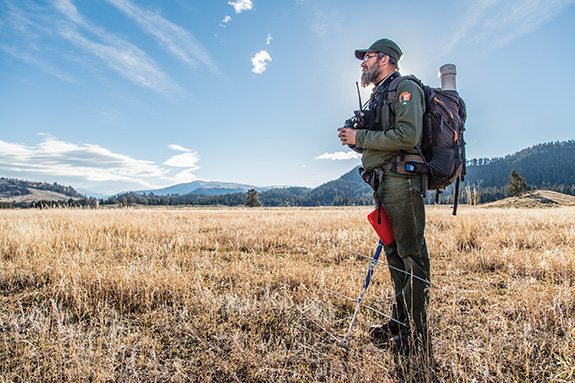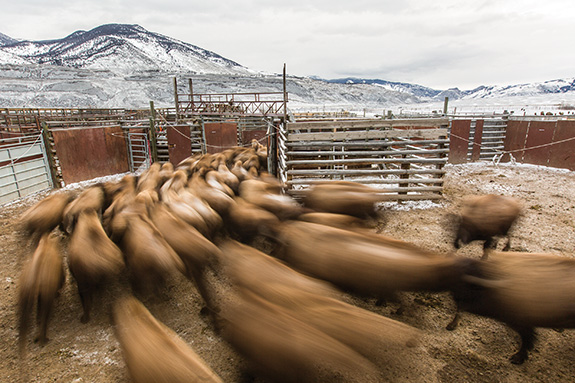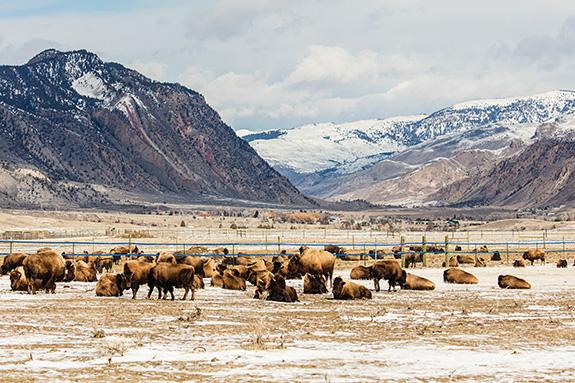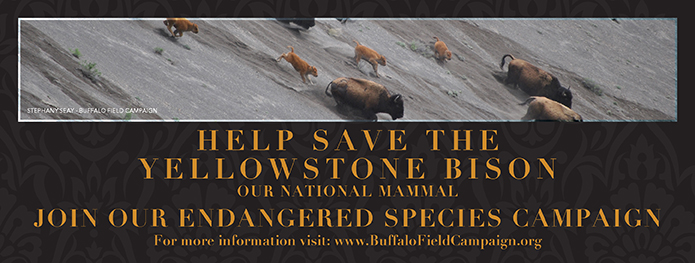A Prairie Home Companion
Wild bison once dominated Montana’s grassland landscapes. Now they’re unwelcome visitors to their native lands. The big question is, why?
We all know the history of wild bison in the American West. There used to be millions; then there were almost none. Nowhere was this transition more pronounced than here in the Greater Yellowstone Ecosystem. Bison were pushed to the brink of extinction—numbering fewer than 50 animals before restoration efforts brought the iconic mammals back to sustainable numbers.
Now, Yellowstone bison are thriving within the borders of Yellowstone National Park. Beyond that, the situation gets a bit more complicated.
Buffalo Soldier: A Yellowstone Bison Biologist Weighs In
Rick Wallen met me on a hot summer day in July. As the lead wildlife biologist for Yellowstone National Park’s bison program, Wallen has fought many battles for the Yellowstone bison. In exchange for beer and BBQ, he agreed to answer some of the most-asked and most complicated questions regarding one of America’s most iconic creatures—indeed, our national mammal. —KRISTIN DANTAGNAN

Kristin Dantagnan
We hear a lot about an Interagency Bison Management Plan. What is this plan and who is in charge of implementing it?
Rick Wallen
The IBMP is the result of the state of Montana getting together with the federal agencies, including the National Park Service and the US Forest Service. The goal is for these agencies to work together to manage the migratory wild bison, as they move across jurisdictions, in a way that meets the needs of all partner objectives and missions. The following agencies work within their own jurisdictions to initiate actions that occur across the full distribution of the Yellowstone bison: The U.S. Department of Agriculture’s Animal Plant Health Inspection Service, the Custer Gallatin National Forest, the state of Montana, the National Park Service, the Confederated Salish and Kootenai Tribes, the Nez Perce Tribe, and the Intertribal Buffalo Council. Each agency brings its own funding and financial resources. So, one can see why this gets complicated.
KD
Wow. That’s a lot of cooks in the kitchen! Is this the best way to manage the bison?
RW
In theory, this is a way to share the workload and responsibility. The animals move across agency lines and this gives each agency an opportunity to invest in the animal they consider iconic, sacred, and in some cases, entitled to. In reality, when the bison do move into another agency’s jurisdiction, there is resistance to take the hand off. Some think, or rather want, the Park to carry the load.
KD
How many bison are there in Yellowstone?
RW
Last summer we estimated the bison population to be about 4,800. Based on winter management actions and weather events, I expect this year’s estimate to be between 4,300 to 4,500 bison. Each year we post a population report on the Interagency Bison Management Plan’s public website, ibmp.info.
KD
We know that some bison leave the Park; however, it seems that most of the bison in the park, stay in the park. Why?
RW
Bison are grassland-seeking ungulates and the Park has several large grasslands that attract them where they survive best. They are large grazing animals and gather in large groups during mid-summer to breed and pass along their gene codes to the next generation. They are very capable of migrating long distances, especially if they know what the habitat looks like at the other end of a migration route. After the breeding season subsides in mid-August, the large groups will begin to disband and move about more widely across a larger landscape. During winter, some will seek low-elevation areas sooner than others, but eventually when the late winter or early spring weather shifts to periodic melting of the snowpack and refreezing at night, the bison must look for areas of shallow or no snow cover, which are usually either south-facing slopes or low-elevation areas that melt earlier.
Bison are very smart. They recognize where and when they are in danger. Bison have pioneered into new areas since they were first returned to the Lamar and Hayden valleys in the interior of the Park. They move to low-elevation grazing sites along the Madison River and along the Yellowstone River. When they leave the protection of the national park, they sometimes encounter hunters. That experience will cause some to return to the interior Park ranges and deal with snowpack rather than remain where the grazing may be easier.
KD
What is the biggest threat to Yellowstone bison?
RW
I think politicians are the greatest threat to wild bison. The social and political process in society today has made wild bison conservation a very polarizing debate.
KD
We hear a lot about brucellosis and bison. What is brucellosis and how does it relate to bison?
RW
Brucellosis is a disease caused by the bacteria Brucella abortus. It invades the reproductive system of grazing ungulates and causes them to abort their calves. Humans are susceptible to this disease as well, but since the advent of the pasteurization of dairy products, the threat to humans is significantly reduced. Bison are a transmission host for this disease. The local bison and elk populations likely became infected a century ago when we humans brought domestic cattle to the region to stabilize our food source. Brucellosis was widespread in the United States in the early 1930s when pasteurization was not yet common. Currently, all 50 states hold a brucellosis-free status. It is now limited to wild elk and bison in the greater Yellowstone region of Wyoming and Montana.
KD
If elk also carry brucellosis, why do bison take all the heat?
RW
Good question. Not only do elk share the responsibility in carrying brucellosis, during the past 40 years, wild elk have been the primary transmission vector to cattle in the tri-state area of the greater Yellowstone. And, there has yet to be a confirmed case implicating wild bison as the likely transmission vector to our neighboring cattle rancher’s animals. There have been nearly 30 cattle infections in the tri-state region in the past 40 years. While bison are considered iconic and a true symbol of the American West, they don’t facilitate the local economy the same way elk do. For example, local and out-of-state residents hunt elk. Those out-of-staters bring in lots of dough. Hunting and guiding outfits profit from the elk as well.
KD
Of course. Money talks, or in this case, doesn’t. Sounds like a perfect case of “see no evil, hear no evil, speak no evil.”
RW
Smiles.
KD
Why isn’t there more winter range outside the Park?
RW
There is a lot of winter range outside of Yellowstone National Park for grazing ungulates. However, many humans have lost interest in co-existing with wildlife on the landscape. Admittedly, many people move to the greater Yellowstone area to experience the abundant wildlife, but learning to live with wild bison and wild elk requires us to be cognizant of how to act around these large animals.
If grass is an important part of your business and you don’t have enough grass to share with the wildlife, then it is understandable why some folks do not want to accommodate wild elk and bison on their private property.
KD
When bison do wander off and out of the Park, who handles the roundup, hazing, hunting, and transport to slaughter?
RW
When it is determined that bison need to be captured (for whatever reason the decision-makers deem necessary), then the National Park Service is responsible for that action at the north boundary of the Park. The state of Montana is responsible for that action at the west boundary. Hazing has become mostly unnecessary and whether it was necessary to begin with is a matter of personal values.
Transport to slaughter has been organized a bit differently depending on which boundary that action occurs, as mentioned above. The state of Montana, Yellowstone Park, or in some cases, a particular American Indian tribe handle the process. If an Indian tribe transports the animal to slaughter, there is no cost to the tribe and they are free to use the animal for personal and cultural purposes.
Culling of bison, either through hunting outside the boundary of the Park or by capture and consignment to our tribal partners for slaughter, is the most controversial aspect of our bison-conservation program. The NPS has been so successful at restoring wild bison to the landscape that we have caused others (the state of Montana and USDA) much grief and disgust because they don’t want to see wild bison migrate beyond the Park boundary.

Consequently, the State of Montana filed a complaint in Federal Court in 1995 to request the NPS limit the number of bison that migrate to suitable habitat outside the Park in Montana. That complaint was settled by a court-appointed mediation process and the Secretary of the Interior signed a decision document (along with the Secretary of Agriculture) in December of 2000. That decision document directed the NPS to implement the negotiated settlement. The governor of Montana signed a state decision document with the exact same words in it as the federal decision document.
The bison population has done well enough since the settlement agreement was enacted to maintain abundance above the agreed-to condition. Again, the success shown by wild bison to reproduce and survive has angered citizens at both ends of the spectrum. Many in the livestock-production industry are constantly mad at the Park Service because some bison migrate out of the Park each year. They worry mostly about bison breaking their fences and eating the grass that they value for feeding their cattle. They also argue that brucellosis is a significant threat to their livelihood and because some bison are infected with brucellosis, they prefer the bison range be limited at this time. This argument seems unreasonable to some when elk, which are transmission vectors of the same disease, are allowed to roam on a much wider area, and are managed where conflicts occur, rather than restricted to the Park and a few small areas surrounding the Park.
On the other hand, many people who value wildlife conservation are constantly mad because the NPS has to kill many bison each year to uphold our responsibility identified in the settlement agreement brokered by a federal judge. My barometer for success is when the cattlemen and the wildlife-conservation supporters are equally mad at me. Then, I have likely found some middle ground where a bison population can exist on the Yellowstone landscape and fulfill the ecological role their ancestors accomplished when they roamed a much larger area.
Managing public-trust resources is no easy task. Honorable public servants sometimes get forced into retirement when the winds of political power decide to exert their influence and sway management practices toward their preferred interest and away from the common interest that is intended to find the greatest good for the greatest number of constituents.
KD
Why can’t bison be transferred and re-established to other places instead of slaughtered, culled, or hunted?
RW
The National Park Service has been a proponent of relocating live Yellowstone bison rather than the present consignment to slaughter process that was initiated prior to the establishment of the current interagency management plan. The state of Montana exhibited greater support for this type of proposal in 1995 than they do presently. State bison managers have described rather stringent conditions for which they would support the relocation of live bison. The United States Department of Agriculture also has previously expressed more support for relocating wild bison than they do at this time. Supplementing existing herds and establishing new herds of bison with animals from the Yellowstone population is feasible.
KD
But not happening?
RW
Not yet, but we have not abandoned the idea.
KD
Okay, Rick, if you were a wild Yellowstone bison, what would you most like to tell me?
RW
If I were a wild bison, I would tell you that my descendants have been here on the landscape for many centuries. Give us the respect that humans have given to other wild grazing animals and let us find places where we can coexist with humans again. There likely are not many places that wild bison can live outside national parks and Wilderness areas, but do not exclude bison from public lands if there are no real conflicts that threaten humans. Wild bison can enrich the lives of those who choose to accept and protect them.
Bison Fact Sheet
Over 60 MILLION bison once roamed North America
By 1884, 325 left in the wild; 25 in Yellowstone
Historically: occupied over 40 states
Currently: small populations in 6 states and 1 Canadian province
2,300-5,500 in Yellowstone
31,000 in North America in 68 conservation herds
1,155 culled from Yellowstone herd in 2018
Timeline: Yellowstone Bison Across the Ages
1500s: 30 to 60 million bison in North America
1800s: commercial hunting begins
1884: 325 wild bison left in the United States (25 in Yellowstone)
1902: 21 bison purchased from private owners and moved to Lamar Buffalo Ranch
1917: Brucellosis documented in Yellowstone bison (likely from cattle)
1936: 70 bison relocated from northern range to central Yellowstone to form Mary Mountain herd
1952: Last supplemental feeding by NPS
1954: 1,300 free-roaming bison in Yellowstone
1976: Significant number of bison begin migrating out of the Park near the north boundary
1983: Bison begin seasonal migrations outside the west boundary of the Park
2000: Interagency Bison Management Plan established to guide actions across state, federal, and tribal lands; partnership includes MT FWP, MT DOL, NPS, USFS, and USDA.
2009: Confederated Salish and Kootenai Tribes, InterTribal Buffalo Council, and Nez Perce Tribe become cooperating agencies within Interagency Bison Management Plan.
2015: Governor Bullock expands bison-tolerant migration corridors outside of Yellowstone’s north and west boundaries
2018: Three Buffalo Field Campaign Activists arrested for attempting to stop bison slaughter at Park holding pens















